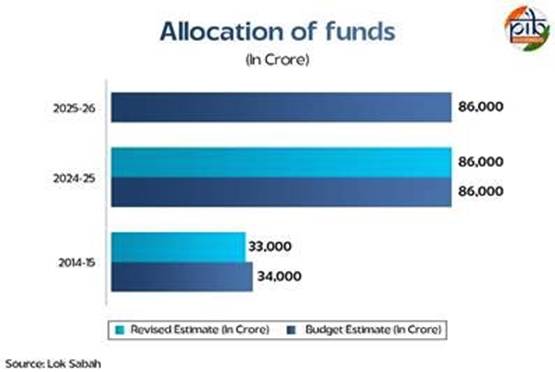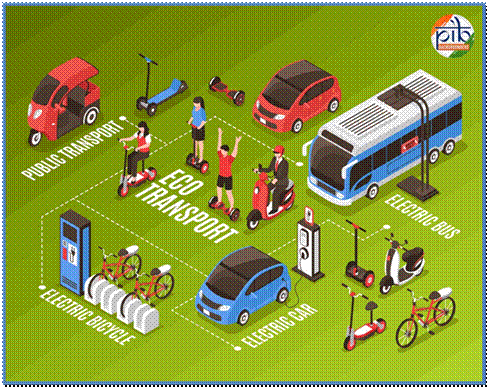Content
- MGNREGA: Building Rural Resilience
- Wheels of Change: India’s Electric Leap for Green Mobility
MGNREGA: Building Rural Resilience
Basics of MGNREGA
- Full Name: Mahatma Gandhi National Rural Employment Guarantee Act, 2005.
- Nature: Rights-based, demand-driven wage employment programme.
- Guarantee: At least 100 days of unskilled manual work per rural household in a financial year.
- Coverage: All districts of India (except those with 100% urban population).
- Legal Basis: Act of Parliament, making employment a legal entitlement.
- Primary Goals:
- Employment generation
- Creation of durable rural assets
- Strengthening rural livelihoods
- Promoting social inclusion (SCs, STs, women, landless labourers)
Relevance : GS 2(Governance , Schemes)
Objectives
- Provide 100 days of unskilled manual work as per demand.
- Strengthen livelihood resource base of rural poor.
- Ensure social inclusion of marginalized groups.
- Empower Panchayati Raj Institutions (PRIs) in planning and implementation.
- Promote sustainable rural development (water conservation, afforestation, soil health, rural infrastructure).
Budgetary and Employment Data
- FY 2013–14: ₹33,000 crore allocation.
- FY 2025–26 (BE): ₹86,000 crore – highest since inception.
- Funds released (till July 2025): ₹45,783 crore (₹37,912 crore for wages).
- Employment Generation:
- FY 2024–25: 290.60 crore person-days.
- Households provided work: 15.99 crore.
- Women Participation:
- 2013–14: 48%
- 2024–25: 58.15% (440.7 lakh women)
Social Inclusion & Women Empowerment
- Consistent >50% participation of women for last 5 years.
- Scheme supports SCs, STs, women-headed households, landless labourers.
- Women’s higher participation indicates shift towards economic inclusion & empowerment in rural areas.
Technological & Governance Reforms
- Aadhaar Seeding & APBS:
- 13.45 crore workers Aadhaar-seeded (2025).
- 13.05 crore linked to Aadhaar Payment Bridge System (APBS).
- eFMS (e-Payments):
- Wage payments through banks increased from 37% (2013–14) → 99.94% (2025).
- Geo-tagging:
- 6.36 crore assets geo-tagged for transparency.
- Digital Platforms:
- NMMS App: Real-time attendance with geotagged photos.
- GeoMGNREGA: Asset tracking.
- Yuktdhara Portal (with ISRO): Geospatial planning.
- JALDOOT App: Groundwater monitoring.
- JANMANREGA App: Citizen information & feedback.
- SECURE software: Estimation of rural works cost.
Asset Creation and Sustainability
- Individual Assets: Grew from 17.6% (2013–14) → 57.05% (2025).
- Agri & Allied Activities: 44.14% of expenditure by 2025, strengthening agriculture.
- Mission AmritSarovar (2022): Target 50,000 water bodies → achieved 68,000+.
- 86.98 lakh assets created (by March 2025): water harvesting, irrigation canals, soil conservation, plantations, rural infrastructure.
Skill Development
- Project UNNATI (2019): Skilling of MGNREGA workers.
- Target: 2 lakh workers.
- Achieved: 90,894 workers trained by March 2025.
- Goal: Transition workers from partial employment to self/wage employment.
Transparency, Accountability & Monitoring
- Social Audit: Mandatory twice a year in Gram Panchayats.
- Fake Job Card Cancellation:
- FY 2024–25: 58,826 deleted (fake, duplicate, migrated, or expired).
- On-time Fund Transfer Orders (FTOs): 97.81% by March 2025.
- Citizen Information Boards: Display works, costs, beneficiaries for community monitoring.

Convergence & Rural Development
- Convergence with 13 ministries:
- Border Roads Organisation (BRO) – rural connectivity.
- Women & Child Development – Anganwadi centres.
- Panchayati Raj – GP buildings.
- Strengthens rural infrastructure while ensuring job creation.
Strengths
- Legal entitlement, not a welfare dole.
- Demand-driven nature prevents underemployment.
- Strong women’s participation – gender inclusive.
- Environmental focus – afforestation, water bodies, soil conservation.
- Technology-driven reforms – minimizes leakages, boosts accountability.
- PRIs empowerment – bottom-up planning through Gram Sabhas.
Challenges
- Delayed wage payments despite high digital integration in some states.
- Corruption and ghost job cards (though Aadhaar reduced it).
- Asset quality varies across states; sometimes non-durable.
- Under-utilization of skilled labour (scheme restricted to unskilled manual work, except under convergence projects).
- Urban poor excluded – rural-centric only.
Recent Developments (2025)
- Record allocation of ₹86,000 crore.
- Nearly 99.8% demand for work met in 2025–26 – strong responsiveness.
- 6.36 crore assets geo-tagged ensuring public monitoring.
- Convergence push: Anganwadi centres, GP buildings, border roads.
- Focus on agriculture-linked works (irrigation, soil health, water harvesting).
Way Forward
- Ensure timely wage disbursal across all states.
- Expand Project UNNATI for large-scale skilling & rural entrepreneurship.
- Stronger social audits to reduce leakages.
- Greater urban employment guarantee linkage for migrant workers (debated idea).
- Focus on asset quality & durability to ensure long-term rural development impact.
- Enhanced climate resilience projects: water recharge, agroforestry, renewable energy-based assets.
Conclusion
- MGNREGA has evolved into India’s largest social security and rural livelihood programme.
- It acts as a safety net, empowerment tool for women, and infrastructure builder for villages.
- With high allocations, strong tech integration, and convergence with rural development programmes, it is central to resilient, inclusive, and sustainable rural growth.
Wheels of Change: India’s Electric Leap for Green Mobility
Background and Context
- Transport sector share in emissions:
- Globally contributes ~23% of CO₂ emissions.
- In India, transport accounts for ~13.5% of total energy-related CO₂ emissions.
- Dependence on fossil fuels:
- 85% of crude oil demand is imported → creates energy insecurity and trade imbalance.
- Urbanisation pressure:
- Rising vehicle ownership (390 million registered vehicles in India, 2025) → worsens congestion, pollution, and oil demand.
- Solution pathway: Shift towards Electric Vehicles (EVs), supported by renewable power integration, aligns with India’s commitments under the Paris Agreement, COP26, and Net Zero 2070 goal.
Relevance : GS 3(Infrastructure , Environment)
India’s EV Journey – Timeline of Policy Push
- 2013: National Electric Mobility Mission Plan (NEMMP) launched.
- 2015–2019: FAME-I implemented → ₹895 crore sanctioned.
- 2019 onwards: FAME-II (₹11,500 crore) focusing on mass adoption, e-buses, and charging infra.
- 2021: PLI-Auto & ACC Battery Storage PLI announced.
- 2023: PM e-Bus Sewa launched (10,000 buses).
- 2024: PM E-Drive & SPMEPCI launched → targeted push for e-trucks and e-cars.
- 2025: India becomes Suzuki’s global EV hub with e-VITARA exports to 100+ countries.

Current Status (as of Feb 2025)
- EV stock: 56.75 lakh registered EVs (~1.5% of total vehicles).
- Sales growth:
- E-2Ws (FY 2024-25): 11.49 lakh sales (+21% YoY).
- Strong uptake of e-3Ws and e-buses in urban mobility.
- Charging infra: 8,885 public charging stations (PCS) installed, out of 9,332 sanctioned.
- Domestic battery ecosystem:
- Localisation of >80% of hybrid battery electrodes.
- 40 GWh battery capacity awarded under ACC-PLI (out of 50 GWh target).

Key Government Schemes Driving EV Transition
A. FAME (Faster Adoption and Manufacturing of Electric Vehicles)
- FAME-I (2015-19): Supported 2.55 lakh EVs, 425 e-buses, and ~520 charging stations.
- FAME-II (2019–2025):
- ₹11,500 crore outlay.
- Supported 16.29 lakh EVs till June 2025, including 14.35 lakh e-2Ws, 5,165 e-buses.
- Charging infra: 9,332 sanctioned → 8,885 installed.
B. PLI Schemes
- PLI-Auto (₹25,938 crore): Attracted ₹29,576 crore investments; created ~45,000 jobs.
- PLI-ACC (₹18,100 crore): 40 GWh awarded capacity; minimum 25% localisation in 2 years, 60% by year 5.
C. PM E-Drive (2024–28)
- ₹10,900 crore scheme.
- Subsidies given for 24.79 lakh e-2Ws, 3.15 lakh e-3Ws, 14,028 e-buses, and 5,643 e-trucks.
- ₹2,000 crore for charging infra on highways and cities.
D. PM e-Bus Sewa (2023)
- ₹20,000 crore scheme → 10,000 buses under PPP.
- 7,293 buses approved in 14 states and 4 UTs.
- ₹1,062 crore sanctioned for depots and charging infra.
E. SPMEPCI (2024)
- To attract global automakers → allows import of e-cars at 15% duty (vs 70–100% normally).
- Mandatory 25% localisation in 3 years, 50% in 5 years.
Supporting Initiatives
- India Electric Mobility Index (IEMI, 2025) → first framework ranking states on EV adoption.
- Delhi, Maharashtra, Chandigarh = “frontrunners”.
- EV testing infra: ₹780 crore allocated for quality and safety improvements.
- Oil companies’ role: IOCL, BPCL, HPCL sanctioned ₹800 crore for 7,432 charging stations.
- Export push: Suzuki’s e-VITARA BEV plant makes India global EV export hub.
Advantages of EV Transition
- Environmental: Lower GHG emissions, reduced PM2.5 & NOx levels.
- Economic: Cuts oil import bill, generates jobs in EV & battery manufacturing.
- Social: Cleaner air in cities, reduced health burden due to pollution.
- Strategic: Enhances energy security, aligns with “Aatmanirbhar Bharat”.
Challenges
- High upfront cost of EVs vs ICE vehicles.
- Charging infra gaps → only ~9,000 public chargers for 56+ lakh EVs.
- Battery supply chain dependence on lithium, cobalt, nickel (mostly imported).
- Grid integration → renewable share must rise for EVs to be truly green.
- Disposal & recycling of used batteries → environmental hazard if unchecked.
Future Targets & Vision
- EV penetration goal: 30% of total vehicles by 2030 (aligned with EV30@30 initiative).
- Emission reduction:
- Cut carbon emissions by 1 billion tonnes by 2030.
- Reduce carbon intensity by 45% (relative to 2005 levels).
- Net-zero by 2070.
- Battery localisation: Target 50 GWh domestic manufacturing capacity.
- Urban mobility: Full electrification of public bus fleet in Tier-1 and Tier-2 cities by 2030.
Conclusion
- India’s EV transformation is no longer aspirational but structurally embedded in policy, industry, and public life.
- With rising adoption (56.7 lakh EVs), localisation of battery production, and export-oriented manufacturing (e-VITARA), India is set to be a global EV hub.
- The success hinges on:
- Faster charging infra rollout.
- Securing mineral supply chains.
- Recycling ecosystem for batteries.
- Convergence of EV adoption with renewable energy expansion.
India is not just riding the “EV wave” but driving it globally by blending climate responsibility, industrial growth, and technological innovation.



